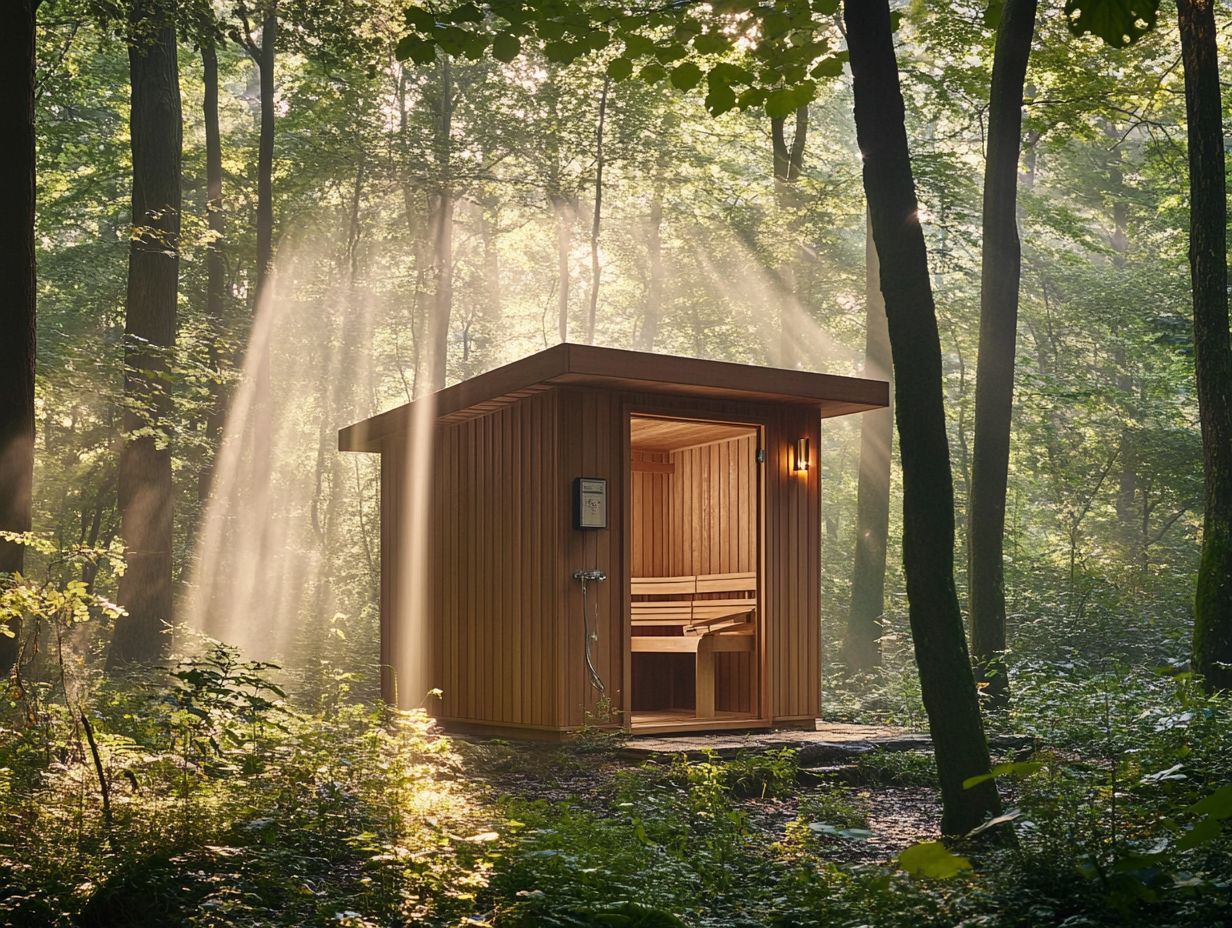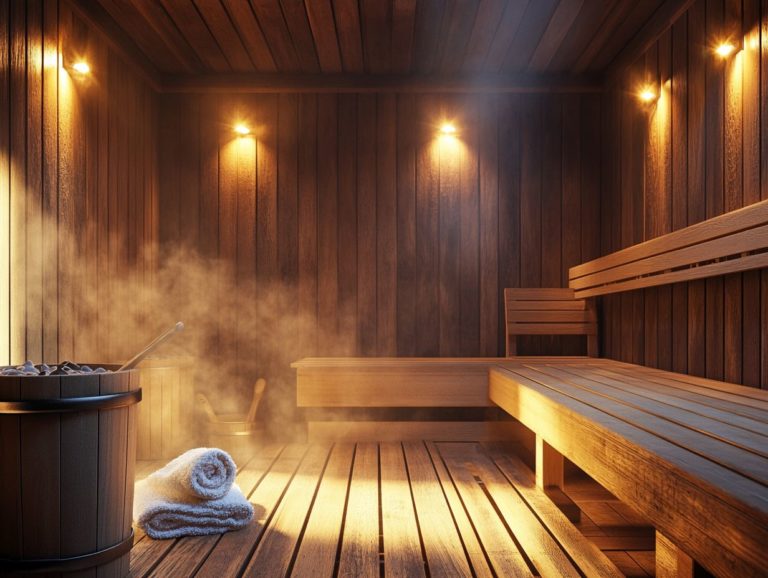What Are the Environmental Benefits of Saunas?
Saunas, including traditional and eco-friendly options, are not just a serene retreat; they provide an array of environmental and health benefits, making them an excellent addition to your wellness routine.
This article delves into various types of saunas, including infrared and outdoor saunas. Discover amazing health advantages that can transform your well-being! You ll see how saunas can help you reduce your carbon footprint, conserve energy, and improve air quality. It also explores practical tips for making your sauna experience even more eco-friendly.
Prepare to elevate your well-being while being a friend to Mother Earth!
Contents
Key Takeaways:

- Eco-friendly saunas help you shrink your carbon footprint by using less energy.
- Regular sauna use not only conserves energy but also boosts air quality.
- Make your sauna experience greener by choosing sustainable materials!
What is a Sauna?
A sauna, including options like Finnish saunas, is a carefully designed space intended for immersive heat sessions, where heat envelops your body. It is typically constructed from beautiful wood types like cedar, Canadian hemlock, or Basswood. These selections not only provide a unique aromatic experience but also enhance your time spent in the sauna.
You ll find these serene spaces perfect for relaxation and for reaping health benefits, such as improved cardiovascular function, detoxification (the process of removing toxins), and enhanced lung function.
With options ranging from traditional saunas to infrared varieties, and even eco-friendly designs that emphasize sustainability and energy efficiency, you have the opportunity to choose a sauna that aligns with your lifestyle and wellness goals.
Types of Saunas
There are many types of saunas available, including portable saunas and steam rooms, each designed to provide a distinct experience. You ll find yourself navigating through traditional saunas, infrared saunas, eco-friendly options, portable versions, and outdoor retreats, each utilizing different heating methods like wood-burning stoves or electric heaters.
Traditional saunas are renowned for their high heat and humidity, employing heated rocks to create an intense atmosphere that invigorates the senses. In contrast, infrared saunas work by penetrating the skin more deeply at lower temperatures, delivering a gentler yet highly effective warmth that many find soothing.
If you lean towards sustainability, eco-friendly saunas incorporate sustainable materials and energy-efficient designs, making them a perfect choice for the environmentally conscious individual. For those who are always on the move or have limited space, portable saunas and outdoor saunas are game-changers, allowing you to enjoy the wellness benefits wherever you are.
And let s not forget outdoor saunas, which beautifully invite you to connect with nature, enhancing your relaxation experience by combining the refreshing embrace of fresh air with the soothing allure of heat.
Environmental Benefits of Saunas
The environmental benefits of saunas are growing more obvious, especially with the emergence of eco-friendly options. These saunas are thoughtfully designed to minimize their environmental impact by incorporating sustainable materials, energy-efficient heaters, and renewable energy sources.
By choosing such saunas, such as those certified by eco-labels or fitted with solar panels, you re not just indulging in a personal wellness ritual; you re actively contributing to a reduction in the carbon footprint associated with your self-care practices. Consider making the switch to an eco-friendly sauna today!
Reducing Carbon Footprint
Reducing your carbon footprint during sauna use is entirely within reach when you embrace eco-friendly saunas that harness renewable energy sources, such as solar panels. These saunas also boast energy-efficient designs. This approach beautifully aligns your personal wellness journey with a commitment to environmental stewardship.
By integrating features like solar panels and better insulation that keeps the heat in, you can significantly cut down on energy consumption and tap into cleaner energy alternatives. This reduces maintenance costs and overall energy bills. Opting for sustainably sourced and manufactured materials elevates the eco-friendliness of your sauna installation even further.
Incorporating smart technologies, such as temperature controls and automated systems, gives you the power to optimize your heat usage, minimizing energy waste. You can also adopt practices like using saunas during off-peak hours or frequenting communal facilities to markedly reduce your environmental impact.
Collectively, these choices not only contribute to a more sustainable lifestyle but also deepen your connection with nature, making your sauna experience all the more fulfilling.
Conserving Energy

Energy conservation in saunas can be greatly enhanced when you incorporate energy-efficient heaters and thoughtfully designed eco-friendly features. This leads to lower maintenance costs and helps in reducing your energy bills over time.
Consider investing in advanced heating systems that utilize cutting-edge technology, like infrared heating a type of heating that warms you directly, rather than warming the air and programmable thermostats. These innovations not only save energy but also enhance your sauna experience! Proper insulation and the strategic placement of heaters are essential for maintaining the desired temperature without unnecessary energy expenditure.
By embracing these practices, you contribute to environmental sustainability while enjoying longer-lasting equipment and heightened user satisfaction. Ultimately, these steps allow you to adopt a mindful approach to wellness, ensuring that personal enjoyment and energy conservation go hand in hand.
Improving Air Quality
Improving air quality is one of the often-overlooked perks of using saunas, especially eco-friendly options like infrared saunas that utilize natural materials and advanced ventilation systems. These features work together to enhance your lung function and overall respiratory health.
In these saunas, you’ll often find untreated wood, which not only emits a delightful aroma but also minimizes the release of harmful chemicals into the air. Designs featuring large windows and strategic airflow facilitate fresh air circulation, ensuring you don t end up in a stale environment that could aggravate any respiratory issues.
Maintaining lower humidity levels in these spaces inhibits the growth of mold and other allergens, creating a sanctuary that promotes easier breathing and overall wellness. This is particularly beneficial for those with chronic respiratory conditions like asthma and chronic bronchitis. The health benefits stretch beyond simple relaxation; exposure to cleaner air in these environments can boost your cardiovascular function and support a more robust immune response.
Health Benefits of Saunas
The health benefits of saunas, including traditional saunas and infrared saunas, are extensive, presenting therapeutic effects that can assist in managing blood pressure and lowering the risks of cardiovascular disease. They can even offer relief for neurocognitive diseases and chronic respiratory conditions like asthma and pneumonia.
Through detoxification and enhanced lung function, regular sauna use can significantly contribute to your overall well-being. Explore the psychological benefits of weekly sauna visits and don’t miss out on the chance to improve your health!
Physical Health Benefits
Regular sauna use offers a wealth of physical health benefits that can elevate your well-being. These benefits include improved cardiovascular function, lowered blood pressure, and enhanced lung function. It s a truly valuable addition to any health-conscious lifestyle.
Research shows that the heat exposure from saunas boosts blood circulation, mimicking the benefits of moderate exercise. This is especially advantageous for those at risk of heart disease. A noteworthy study published in the Journal of the American College of Cardiology revealed that frequent sauna sessions are linked to a reduced risk of heart-related conditions, and exploring the benefits of partnering sauna use can enhance these effects.
Regular sauna use also facilitates detoxification through sweating. This process helps to expel heavy metals and toxins from your bloodstream, potentially enhancing your overall physical wellness. Additionally, the benefits of public saunas suggest that sauna bathing can alleviate symptoms of asthma and bronchitis. The warm, humid air works wonders for improving airway function and clearing mucus.
These amazing benefits make you want to jump into a sauna session right now! Incorporating sauna sessions into your daily routine ensures a mindful approach to wellness.
Mental Health Benefits
The mental health benefits of saunas extend far beyond simple relaxation. Studies suggest that regular sauna sessions may help with brain-related issues and promote overall mental well-being through detoxification processes.
Research indicates that the heat from saunas can boost serotonin production, a neurotransmitter essential for mood regulation. This may help reduce symptoms of anxiety and depression. In fact, a randomized controlled trial showed that participants engaged in sauna therapy experienced significant improvements in cognitive function and memory recall compared to those who didn t.
When you sweat, your body eliminates toxins, leading to a clearer mind and enhanced emotional balance. If you are grappling with stress or mental fatigue, incorporating sauna sessions into your routine, especially through the benefits of barrel saunas, could be an incredibly effective strategy for nurturing both your mental and emotional health.
How to Make Your Sauna More Eco-Friendly

Transforming your sauna into a more eco-friendly sanctuary means embracing sustainable materials, minimizing energy consumption, and incorporating eco-labels that signify your commitment to environmentally responsible practices.
By doing so, you not only enhance your sauna experience but also contribute to a greener and healthier environment.
Tips for Reducing Energy Consumption
- Invest in energy-efficient heaters that help you cut down on energy costs while maintaining cozy warmth.
- Choose heaters with high energy ratings for significant savings and a delightful sauna experience.
- Enhance your insulation using eco-friendly materials to minimize heat loss, conserving energy and elevating comfort.
- Incorporate smart technology like smart thermostats for precise control over your heating schedules, maximizing efficiency effortlessly.
- Perform routine maintenance checks on your equipment to prevent energy wastage and ensure peak performance.
By following these tips, you can enjoy your sauna while being kind to the environment. Start your eco-friendly sauna journey today!
Using Sustainable Materials
Choosing sustainable materials like Canadian hemlock, cedar, and basswood elevates the eco-friendliness of your sauna. These natural resources are sourced responsibly and contribute to a healthier environment.
By prioritizing these woods, you support the principles of sustainability and play a vital role in helping to stop tree cutting and reducing carbon emissions. Canadian hemlock is not just durable; it has excellent thermal properties for a truly comfortable sauna experience.
Cedar, on the other hand, shines with its natural resistance to decay, outperforming many synthetic alternatives. This means less frequent replacements and lower maintenance in the long run.
Embracing this approach fosters eco-friendly practices. Thoughtful material selection can lead to an enhanced sauna experience that is kind to both you and the planet.
Frequently Asked Questions
What Are the Environmental Benefits of Saunas?
Saunas can have several positive impacts on the environment. Here are the top environmental benefits of using saunas:
How do saunas help the environment?

Saunas have a low impact on the environment compared to other heating systems. They use less energy, making them more eco-friendly.
Do saunas contribute to reducing carbon emissions?
Yes, saunas contribute to reducing carbon emissions. Traditional saunas use wood as fuel, a renewable resource with a lower carbon footprint than electricity or gas-powered heating systems.
Can saunas help conserve water?
Yes, saunas can help conserve water. In traditional saunas, water is used to create steam, which is then circulated in the room. This means no additional water is needed to run the sauna.
What are the environmental benefits of using infrared saunas?
Infrared saunas use less energy than traditional saunas and have a lower environmental impact. They also produce less waste and do not require water to operate.
Are saunas energy-efficient?
Yes, saunas are energy-efficient. Traditional saunas use less energy than other heating systems, and infrared saunas use even less. This makes them a more sustainable option for heating and relaxation.






